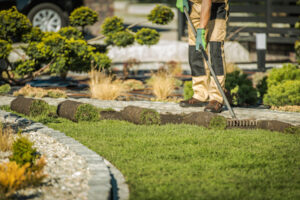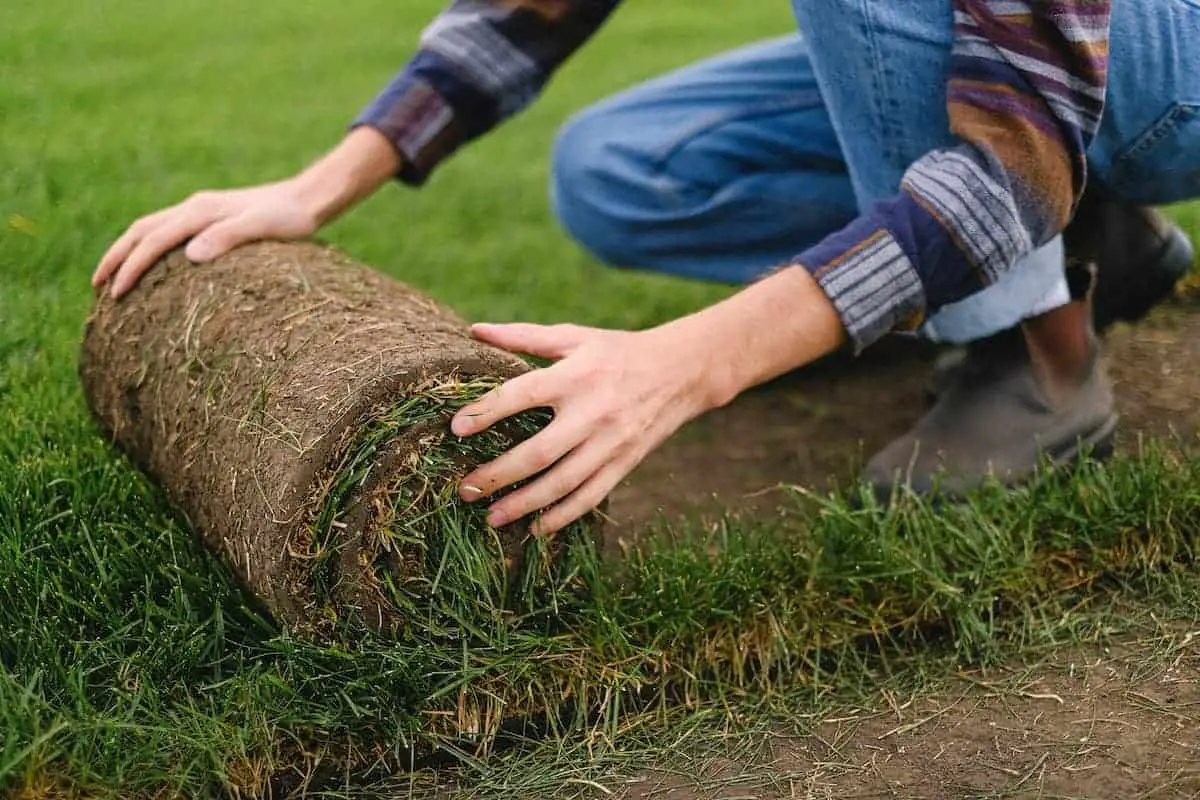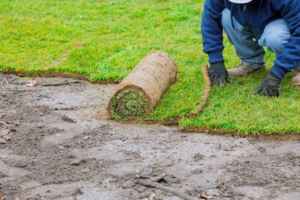What You Should Know About Fescue Sod
If you are looking into planting grass, you may be wondering how long it takes for fescue sod to take root. Fescue sod is a great alternative for many homeowners.
So, how long does it take for fescue sod to take root? It typically takes about 2-4 weeks for fescue sod to take root completely and spread throughout a lawn. Many factors can influence this growth as well as ways to possibly speed up the process which we will get into a little later.
 Factors That Influence Grass Growth
Factors That Influence Grass Growth
Several factors have to do with how quickly new grass spreads out through your lawn. First off is being patient enough for this process to finish. Also playing how much water the soil possesses/how frequently it is watered, fertilizer usage, and general maintenance practices on your part play a significant role.
If any of these variables are ignored or not properly managed, it will impede how quickly the sod establishes a healthy root system.
Watering Correctly
A rule of thumb to follow is that for every inch of new sod, it should get 1 inch of water per week. This means if you have 4 inches of new sod, you should be watering it four times a week.
If you are using a sprinkler system as your primary water source, set it at a low pressure to wet the soil gently and slowly. It is also beneficial to water in the morning hours when the sun is not at its peak heat because this allows the soil time to dry before nightfall- helping prevent any potential diseases that could occur from too much moisture.
Fertilizing Correctly
If you installed your sod within the last two weeks, try to refrain from fertilizing until about a week after you installed it. This is because the fertilizer will burn your grass and stunt its growth, which could prevent it from establishing deep roots as soon as possible.
Ways To Speed Up The Process
In case you do not have much time or patience to wait for your new fescue lawn to take root, there are ways you can speed up the process!
1) Aerating Your Soil
Aerating your soil before laying down your sod will help with drainage and allow the soil to absorb water much easier.
2) Mowing And Dethatching Your Lawn
Regularly mowing and dethatching your lawn will help keep the grass healthy and promote new growth.
It is recommended to mow your lawn regularly, and dethatching it every 6-8 weeks will help remove any dead or excess grass that could prevent new growth from taking place.
3) Water Regularly And Properly
Watering correctly is the most important factor when it comes to establishing sod. The amount of water you give your soil directly correlates with how quickly your grass establishes deep roots!
4) Applying A Fertilizer
If all else fails and you just cannot wait for your established patch of fescue to root, you can always buy a fertilizer with quick rooting properties.
Just be sure to read the label and follow the application instructions to a tee, as over-fertilizing could do more harm than good.
Why Your Fescue Would Not Take Root
Many factors could cause a fescue sod not to take root. A common reason is being unable to water your new lawn enough. If you have just put down a few squares of fescue sod, it is important to make sure the soil has plenty of moisture.
Another reason for this could be that you are using too much fertilizer. Be careful not to fertilize past every two weeks, as the excess nitrogen will cause the grass to die off on existing patches or prevent any new growth on bare spots.
The Soil Is Too Hard/ Compacted
The most common reason is that the soil is too hard and compacted. For the sod to take root, the soil needs to be loose and well-drained. If the soil is too dense, the roots will not spread out, and the sod will not take root.
Too Much Moisture
Another reason why a fescue sod might not take root is if there is too much moisture in the soil. If the soil is too wet, the roots will rot, and the sod will die.
Type of Soil
The type of soil also plays a role in whether or not a fescue sod will take root. If the soil is too acidic or alkaline, the sod will not grow.
Time Of Year
The time of year can also affect whether or not a fescue sod will take root. Sod is typically planted in the spring or fall when the weather is cooler and more moisture is in the air.
If you try to plant sod in the summer, it is far more likely that it will dry up and not take root.
An Underlying Issue
If none of these factors are at fault, there may be an underlying issue with the grass variety you have chosen. Some types of fescue will simply never take root. Choosing the right kind of grass for your soil conditions is essential before buying sod.
What Is Fescue?
Fescue is a hearty, low-maintenance type of grass. It can survive in most climates and conditions if it has the right amount of sunlight and water.
Once you lay the sod down in your yard, it will take between seven and 21 days to take root. You can tell that your fescue grass is taking root when it begins to turn a green color and fill in the gaps between the pieces of sod. Fescue sod is offered in a variety of textures and shades.
Some types are thin, while others have thick blades of grass. Fescue comes in neutral tones as well as vivid greens to add pops of color to your yard. The type you choose will depend on your personal preference and the climate in your area.
Why Fescue Sod Is A Good Option
Fescue sod is an excellent option for homeowners who want a lush, green lawn but do not have the time to maintain it.
It also requires less fertilizer and water than other types of grass, making it a cost-effective solution for homeowners that want an easy-to-maintain, vibrant lawn.
1) Easy To Maintain
If you are looking for something that is easy to maintain and lasts a long time, fescue sod might be perfect for your home.
Fescue is one of the most popular types of grasses used on lawns because it looks great, stays green all year round without much effort, has low water needs, does not grow too fast or spread weed seeds, and has a minimum of health problems.
2) Durable
Fescue is one of the most common types of grasses used for home lawns because it is very hardy, can tolerate shade, can endure cold winters and scorching summers.
It requires little to no fertilizer or other chemicals to look green. If you are looking for something that is low effort, fescue sod might be the right choice for you.
3) Weather Friendly
People who live in colder areas of the country may find that fescue sod is one of the most beneficial types of grass because it can withstand winter temperatures without dying or turning brown.
Fescue can also endure heat and drought better than other types of grass. If you live in a hot, dry area, fescue might be your best choice.
4) Disease And Pest Resistance
Fescue sod is also beneficial because it has disease and pest resistance. This means that it does not have to be sprayed with pesticides or herbicides very often, if at all.
Also, the roots grow underneath the sod instead of spreading outward. This means there is less chance that the grass will be affected by weed killers.
5) Little Maintenance
Fescue sod can be installed easily and quickly, making it an excellent choice for people who do not have much time to spend on their lawn.
Once installed, fescue requires very little maintenance. It will only need to be mowed and watered occasionally. Fescue is also resistant to most common lawn diseases. It is a good choice for people who have a history of problems with their grass.
Why Fescue Would Not Be A Good Option
Fescue is grass that grows out of the ground and produces seeds. This allows it to spread rapidly. It has long roots and can do well in shady areas where other grasses fail. However, fescue also has some problems:
1) Poor Wearability
Because fescue takes longer to establish itself than most other types of grass, this means that fescue will be more easily worn down by people walking on it. This is in contrast to other grasses such as Kentucky Bluegrass or Bermuda Grass.
2) Poisonous for Pets
Because pets such as dogs and cats will chew on anything they come across, including your lawn, fescue causes severe health problems for them because it contains a substance called endophytes. These organisms produce toxins that can make your pet very sick, sometimes even leading to death.
3) Grows Too Fast
Fescue sod can quickly take over an area if it is not kept under control. If you are not careful, fescue can quickly become a weed and overtake other plants in your garden.



